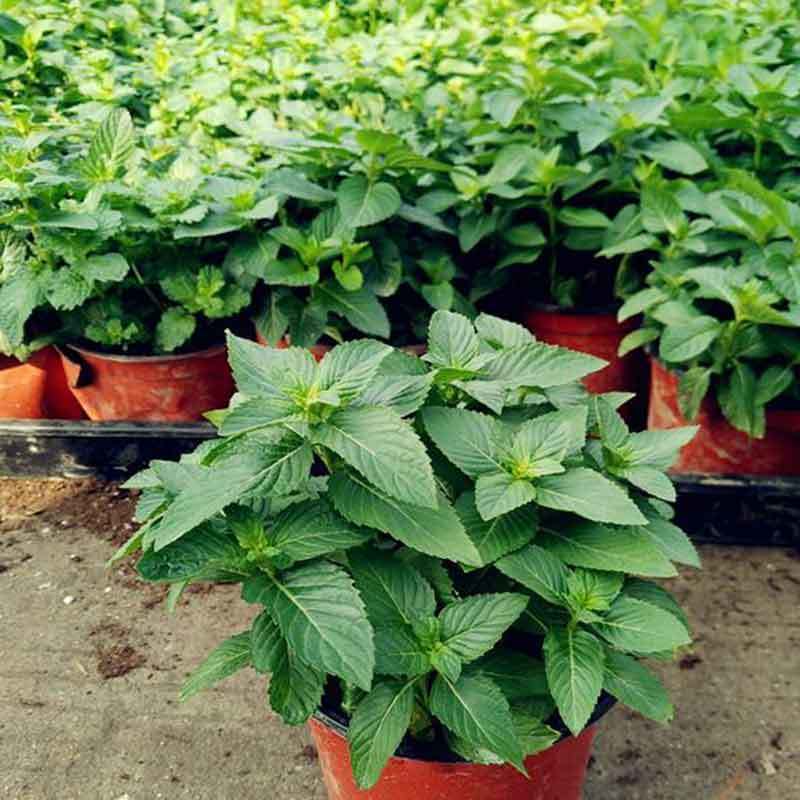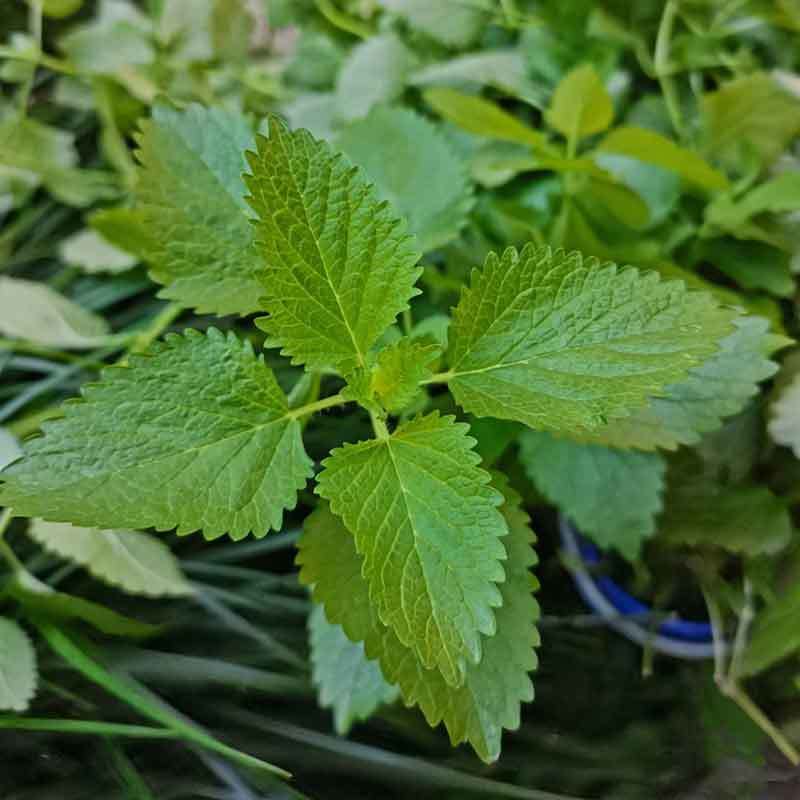A Complete Guide to Growing Lemon Balm in Pots
Introduction
How to plant lemon balm in a pot? Lemon balm has a distinct lemon-like scent and flavor. This makes it popular for culinary, medicinal and cosmetic purposes. We will provide a guide to successfully growing lemon balm in containers.
Benefits of Growing Lemon Balm in Pots
Lemon Balm Annual or Perennial? Lemon balm (Melissa officinalis) is an herbaceous perennial from the mint family. You can use its leaves fresh or dried in many recipes. For example, soups, salads, teas and desserts.
Aromatic Qualities: Lemon balm is known for its pleasant scent, which has a hint of lemon and mint. Lemon balm essential oil has calming effects. You can use it in aromatherapy treatments.
Medicinal Benefits: Lemon balm's healing properties have been utilized for centuries. Lemon balm has antiviral and antimicrobial properties. So it is useful for treating bacterial and viral infections.
Insect Repellent: Lemon balm can keep insects at bay. Because it has a strong smell which can repel ants, flies and other pests. At the same time, it attracts many beneficial pollinators. For example, bees and butterflies.
Choosing the Right Container
Drainage Holes: The lemon balm pot should have drainage holes. This allows excess water to escape. The soil will become waterlogged without proper drainage. This can lead to root rot and poor overall health of the plant.
Material Options: When choosing lemon balm pot materials, there are three main options: clay, plastic and wooden. Clay pots provide good drainage and excellent air circulation for plant roots. But they are quite heavy and prone to cracking.
Plastic growing pots are lightweight and easy to move around. But they may not provide as much air circulation or drainage as clay pots. Wooden containers offer a decorative option for your garden. But they are quite porous and need more frequent re-sealing to avoid water leakage.
Lemon Balm Container Size: Lemon balm in planter can grow up to three feet tall and two feet wide. So you'll need a pot with enough space for its roots and foliage. The general rule is to use a pot that's 6 inches wider and deeper than the root ball of your plant.
Consider the mature size of your plants when selecting a pot. Go for one that is a few sizes bigger than what you think your lemon balm needs. If you're planting multiple plants, leave them at least one foot of space.
Selecting the Right Potting Mix
Create Custom Soil Mix: You should use soil with adequate drainage and rich in nutrients. For example, a combination of compost, potting soil and perlite. Compost provides nutrition to support healthy growth in the herb. Potting soil ensures adequate drainage and aeration for root health. Perlite gives lightweight texture which increases the porosity of heavy soils.
Soil pH: When growing lemon balm in containers, the potting soil pH between 6.7 to 7.3 is better. You can adjust the pH level if necessary. Simply add lime or sulfur to the soil until you reach the desired pH level.

Picking a Suitable Location
Ideal Temperature: Lemon balm thrives best when the temperature ranges from 65 to 75°F. You should avoid growing lemon balm below 45°F.
Sunlight Requirements: Lemon balm will grow in partial shade. But it requires at least 6 hours of direct sunlight per day to produce the best flavor and oil content. You should provide some shade from the midday sun during particularly hot climates.
Balance Between Sunlight and Shade: You should find the right balance between sunlight and shade when growing lemon balm in pots outdoors. The ideal spot should provide your plants with adequate sunlight and protect them from the intense midday heat.
Consider planting in a location with morning sun and afternoon shade. You can also find a spot shaded by other tall foliage from direct sunlight.
How to Grow Lemon Balm in Pots?
Steps for Planting Lemon Balm Seeds in Pots
Soaking Seeds: How to grow lemon balm in a pot? You should soak some lemon balm seeds in warm water for a few hours. The germination process will accelerate and your plant will have the best start.
How many lemon balm seeds per pot? When planting lemon balm seeds, two to four seeds per pot is ideal.
Planting at the Right Depth: Dig a shallow hole first when you're ready to plant lemon balm in pots. Lemon balm seed planting depth is 1/4 inch to 1/2 inch. Cover the seeds with soil and tamp them down firmly.
Covering and Watering: Next, cover the lemon balm seeds with a thin layer of mulch. This helps retain moisture. Water gently until the surface is evenly moist. Place the pot in a sunny spot and keep the soil damp until germination. Once seedlings emerge, thin out any overcrowded areas.
Steps for Planting Lemon Balm Seedlings in Pots
Preparing the Container: Before planting lemon balm, make sure the container has drainage holes along the bottom and sides. Fill the plastic pot with well-draining soil. You can combine equal parts topsoil, sand and compost.
Transplanting the Seedlings: Then, transplant the lemon balm seedlings when all are ready. Water the seedling to keep the roots slightly moist. Carefully place the seedling in the container. Make sure not to disturb too many of its roots. Fill in around the base of the plant with some of the soil mix. Patting down gently to make sure it is firmly in place.
Watering and Providing Initial Care: When you've finished transplanting your seedlings, give them a good drink of water. To ensure even coverage, use a watering can or spray bottle to sprinkle the water over the surface of the soil.
Once your lemon balm plants are established, they'll need regular watering and occasional fertilizing to stay healthy. Water them when the soil dries. Provide an all-purpose fertilizer every two or three weeks.
Watering and Fertilizing Lemon Balm in Pots
Watering Needs: You should water lemon balm in a pot every few days. Lemon balm prefers consistently moist soil, but can root rot if waterlogged. To ensure optimal moisture levels, use a moisture meter to track the soil's wetness between each watering.
Fertilizing Guidelines: Lemon balm benefits from the occasional application of balanced liquid fertilizer. It promotes lush, healthy foliage and reduces pest and disease problems. An easy-to-use organic option is fish emulsion. Apply one tablespoon of water every two weeks during the growing season.
Too much fertilizer can result in weak, leggy stems and discolored leaves. Always follow the directions on the fertilizer package for proper application. Don't fertilize lemon balm during winter months when they are dormant.
Pruning and Maintenance
Pruning for Bushier Growth & Reducing Legginess: When pruning potted lemon balm, focus on the stems that have grown to a full height and remove them at their base. Prune out any excessively tall or leggy branches. You should also deadhead flowers when they start to die off. This prevents your plant from expending energy on producing seeds.
Regular pruning encourages the growth of new stems and leaves. This means a larger crop of herbs to harvest. Pruning also keeps plants looking neat and well-groomed, while preventing overcrowding. This can lead to reduced air flow and pest infestations.
Harvesting Lemon Balm: The best time to harvest is usually just before they bloom. When the essential oils and flavor are at their peak. Snip or pinch the leaves or sprigs at their base. Be careful not to damage other parts of the plant.
Drying & Freezing Lemon Balm: Once you’ve harvested your lemon balm, you can preserve it for later use by either drying or freezing. For drying, you can hang sprigs upside down in a warm, dark place for several days.
If you want to freeze your lemon balm instead, you should blanch the leaves first. Boil small batches of the leaves for a few seconds in boiling water. Then, submerge them in ice cold water to shock them. You can then spread out the blanched lemon balm on a baking sheet and freeze it for several hours.

Dealing with Pests and Diseases
Common Pests: Aphids, spider mites, snails, slugs and caterpillars are common pests. Aphids are on the underside of leaves where they feed on sap. You can identify their presence by noticing the plant wilting or developing a sticky substance on its leaves. Spider mites cause yellowing of leaves. Caterpillars eat into the leaves and create holes in them.
Natural Remedies: Neem oil comes from the seeds of the neem tree. It contains insecticidal properties. It is safe for humans, animals and beneficial insects. You can apply neem oil to the plant every 7-10 days until the pests are gone. Insecticidal soap acts on direct contact with the pest and does not harm beneficial insects.
Common Diseases: Lemon balm is also susceptible to fungal diseases like powdery mildew. To prevent this, keep the leaves dry and not overcrowd plants. Pruning affected leaves or using protective sprays can help control the spread of this disease.
Ensure adequate air circulation by spacing plants correctly to reduce chances of infection. Regularly checking for signs of pests and diseases. Taking timely action is important for maintaining healthy plants.
Transplanting and Repotting
When to transplant lemon balm? When your lemon balm starts to outgrow its pot, it’s time to consider transplanting. The best time of year to move your plant is during the fall or spring. Avoid transplanting during hot summer months. Because this can be stressful on the plant and cause shock.
How to transplant lemon balm? Select a new pot with drainage holes around twice the size of its current one. Fill the bottom third of the pot with fresh soil mix, then carefully remove your lemon balm from its old container. Trying not to disturb its root ball any more than necessary.
Steps for Repotting: Repotting is easy. Start by filling the new pot with fresh soil mix and gently tapping down on the surface. So that the roots have something solid to anchor into.
Next, lay your lemon balm in the center of the pot. Carefully fill more soil around its root ball. Make sure not to compact it too much. Then, water thoroughly and place in a bright spot with indirect sunlight. You should also consider adding an organic fertilizer to your soil mix. This will help your lemon balm establish itself quicker.
Overwintering Lemon Balm in Containers
You should take additional protective measures for cold winter months. If possible, bring the potted plants indoors or to a sheltered location during severe weather and frosts. Another option is to provide protective coverings. For example, burlap sacks or horticultural fleece. You should remove them when temperatures rise during the day.
Lemon balm in containers requires very little water in winter. During the dormant period, you should reduce watering. Adjust your regular care routines accordingly. Prune any dead or wilting leaves and remove any weak or diseased stems.
If you notice whitefly, aphids, scale insects, or powdery mildew on your lemon balm plants, treat them with the appropriate organic pesticide. Regularly check for signs of infection. If your plants are looking unhealthy, move them to a brighter location or increase the amount of fertiliser you give them.
Lastly, your lemon balm should get adequate light during the winter. If you can't provide adequate light indoors during winter, consider moving your plants outdoors as soon as temperatures allow.
Conclusion
Growing lemon balm in pots can enjoy the numerous benefits of this versatile herb right at home. With careful consideration of location, soil and container size, along with regular watering and fertilizer application, you can successfully grow lemon balm in a pot.


